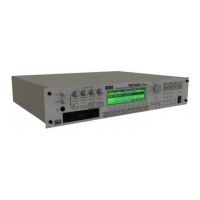PROG
1.1
2.12.22.33.14.14.25.15.25.36.17.17.27.3
5
1.1–3: Arp (Arp. Play)
While arpeggiator parameters are for the most part edited in
PROG 6.1: Ed-Arp., Some major parameters can be edited
here as well. When you are playing in PROG 1.1: Play, you
can edit the arpeggiator in realtime, such as changing the
arpeggio pattern etc.
You can also use the REALTIME CONTROLS C-mode
[TEMPO], [ARP-GATE], and [ARP-VELOCITY] knobs to
edit the arpeggio in realtime (
☞BG p.21).
1.1–3a: Arpeggiator
Pattern [P000...P004, U000(I-A/B)...U327(E–H)]
Reso (Resolution) [ , , , , , ]
Octave [1, 2, 3, 4]
Sort [Off, On]
Latch [Off, On]
Key Sync. [Off, On]
Keyboard [Off, On]
Make settings for the program arpeggiator (☞“PROG: Ed-
Arp.”). These parameters can also be set from 6.1: Ed-Arp.
Arp.” (
☞6.1–1a).
■ 1.1–3b: UTILITY
☞ “Write Program,” “Select by Category” (1.1–1d)
Make basic settings for the oscillator(s) that will be used.
2.1–1: Basic (Prog Basic)
2.1–1a: Oscillator
Mode (Oscillator Mode) [Single, Double, Drums]
Specifies the basic program type; whether it will use one or
two oscillators, or a drum kit.
Single: The program will use one oscillator (Oscillator 1,
Filter 1, Amplifier 1). In this case the program will have a
maximum of 60-note polyphony.
Double: The program will use two oscillators (Oscillator 1/
2, Filter 1/2, Amplifier 1/2). Allowing you to create more
complex sounds. In this case the program will have a maxi-
mum of 30-note polyphony.
Drums: The program will use one oscillator (as when Sin-
gle is selected), but Oscillator 1 will be assigned a drum kit
instead of a multisample. In this case the program will have
a maximum of 60-note polyphony.
2.1–1b: Voice Assign
Mode (Voice Assign Mode) [Poly, Mono]
Poly: The program will play polyphonically, allowing you
play chords.
Mono: The program will play monophonically, producing
only one note at a time.
Hold [Off, On]
On (Checked): Hold is On. Even when you take your finger
off of the key, the note will continue sounding as if it contin-
ued to be held. Unless the “Amp1 EG”, “Amp2 EG” (5.1–3a,
5.2–3) “S (Sustain Level)” is set to 0, the sound will continue
playing.
This is ideal for playing drum sounds, and when you set
“Mode (Oscillator Mode)” (2.1–1a) to Drums, you should
turn Hold On.
Off (Unchecked): Hold is Off. Except for drum programs,
you should normally set Hold Off.
If you turn “Hold” On for a drum program, keys of the
selected drum kit whose “Enable Note Off” parameter
(GLOBAL 5.1–3a) is unchecked will be set to Hold On.
Keys that are checked will be set to Hold Off. If you
select Hold Off, the keys will be set to Hold Off regard-
less of their “Enable Note Off” setting.
Single Trigger [Off, On]
This is available when the “Mode (Voice Assign Mode)” set-
ting is set to Poly.
On (Checked): When the same note is played repeatedly, the
previous note will be silenced before the next note is
sounded, so that the notes do not overlap.
1.1–3a
1.1–3b
PROG 2.1: Ed–Basic
2.1–1a
2.1–1b
2.1–1c
2.1–1d

